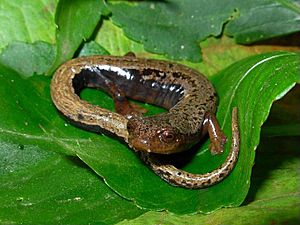Yarumal climbing salamander facts for kids
Quick facts for kids Yarumal climbing salamander |
|
|---|---|
 |
|
| Conservation status | |
| Scientific classification |
The Yarumal climbing salamander (Bolitoglossa vallecula) is a special type of salamander found only in Colombia. It belongs to a group of salamanders called Plethodontidae, which are known as "lungless salamanders" because they breathe through their skin and the lining of their mouths instead of lungs!
Contents
About the Yarumal Climbing Salamander
This unique salamander gets its name from Yarumal, a place in Colombia where it was first discovered. It's a climbing salamander, which means it's good at moving around in trees and other high places.
Where It Lives
The Yarumal climbing salamander lives in the beautiful country of Colombia, in South America. It prefers places that are high up in the mountains.
Mountain Forests
You can find these salamanders in moist, warm mountain forests. These are like rainforests but higher up, where there's lots of rain and the air is humid.
High-Altitude Grasslands
They also live in grasslands that are very high in the mountains. These areas might have tall grasses and fewer trees.
Other Areas
Sometimes, they are found in areas that used to be forests but have been changed by people, like fields where animals graze. Even in these changed places, they try to find spots that are still moist and have cover.
What It Eats
Like most salamanders, the Yarumal climbing salamander is a carnivore, meaning it eats other small creatures. It likely hunts tiny insects and other small invertebrates that live in its habitat. They use their long, sticky tongues to catch their prey quickly.
Life Cycle and Reproduction
Salamanders go through different stages in their lives. Many salamanders lay eggs, often in water or moist places on land. The young salamanders hatch from these eggs.
Young Salamanders
Unlike some amphibians that have a tadpole stage in water, many lungless salamanders, like the Yarumal climbing salamander, hatch as miniature versions of the adults. This means they don't usually need a water stage for their early development. They grow bigger over time, shedding their skin as they get larger.
Conservation Status
The Yarumal climbing salamander is listed as "Least Concern" by the International Union for Conservation of Nature (IUCN). This means that, for now, its population is stable, and it's not considered to be in immediate danger of disappearing. However, it's always important to protect their natural homes to make sure they continue to thrive.
See also
 In Spanish: Salamandra Magra para niños
In Spanish: Salamandra Magra para niños


